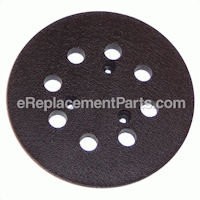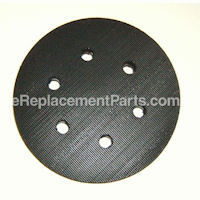Why Read This Article?
Finish Nailer Repair - Replacing the Driver Guide (Ridgid Part # 79004001022)
Article Breakdown
Finish Nailer Repair - Replacing the Driver Guide (Ridgid Part # 79004001022)
Grit Like all abrasive products, grit is the most prominent feature that will effect the aggressiveness of of sandpaper. Although the grit scale for sandpaper products is similar to grit scales of other abrasive types, it goes by another name. Sandpaper manufacturers use the CAMI (Coated Abrasives Manufacturers Institute) grit system. Like other grit scales, it simply uses round numbers to represent the size of abrasive grains in place of actual, tiny measurements.
Most sandpaper products are manufactured and used in the range of 24 and 1000 grit on the CAMI scale. [Back to top] Mount Styles
With all the spinning that sandpaper wheels do, they have to be affixed to their tool somehow. The three most common methods of sandpaper adhesion are adhesive back, hook and loop, and arbor shaft. Because adhesive back and hook and loop sanding wheels are typically mounted on backer pads, we also include some information on backer pad properties.
Adhesive Back-
These sander pads have a pressure sensitive adhesive on their reverse side. By peeling off the adhesive label, just like a sticker, the sticky side is exposed and can be applied to a backer pad.
These sander pads are less expensive than hook and loop pads, but they have one major drawback.

Switching pads can contaminate the adhesive side with dust or something else that makes it less sticky, often making the pad useless. If an application requires changing sander pad grits a lot, it might be better to go with a hook and loop system.
One way to get around this drawback is by keeping a can of spray adhesive around. It can be a little messy, but spraying the back of adhesive sander pads between changes can keep them holding tight.
Hook and Loop-
"Hook and loop" is the same thing as "Velcro," Velcro being a specific, trademarked hook-and-loop system. One side is covered with hooks, and the other side is covered with loops. When they are put together, the hooks fasten around the loops and they hold tightly to one another.
The beauty of this system is that it is simple, durable, and reusable. Hook and loop pads can be removed again and again without becoming less adhesive.

Hook and loop pads are more common than adhesive pads, because they are so simple and durable. Of course, they're usually the better option for applications that require a lot of pad switching, because their adhesiveness wears very slowly. Also, their adhesiveness is less affected by dirt and other particles.
Spindle-
Although less common, some sanding pads are manufactured pre-affixed on the end of an arbor shaft, spindle, or mandrel. These tend to be more expensive (because of the extra materials), and only for very specific sanding applications.
Backer Pads-
Backer pads are not a style of sander pad adhesion. Backer pads are another tool accessory that adhesive back and hook and loop sandpaper discs are usually adhered to, and are then, in turn, attached to the power tool being used to do the sanding.
Because of this, the first and most obvious distinction between backer pad designs is whether or not they are suited for hook and loop wheels or adhesive back wheels.
Backer pads are also manufactured in different materials that partially contributed to the abrasive performance of sandpaper, usually rubber, paper, and phenolic compounds.
The reason for the different materials is that they provide different levels of stiffness to the sanding application, and therefore effect the aggression of the sandpaper. The rule of thumb is that stiffer backer pad materials increase a sandpaper's aggression.
[Back to top]
Sandpaper Disc Backing Materials
The backing material upon which a sandpaper's abrasive grains are bonded has a lot to do with how the disc will perform, both in terms of aggression and durability.
Lighter, flexible backing materials (like paper) are generally for sandpapers that will see lighter work, because heavier applications risk tearing the pads.
The type of backing material also partially determines the flatness of the pad, which in turn modifies how level or not a sandpaper pad will remove material.
Paper-
Sanding wheels with paper backing are most commonly used for woodworking applications, as more aggressive applications would risk tearing pads. Paper discs are generally more flexible as well, suiting them better for contoured work and finer sanding jobs.
Paper sanding wheels are also manufactured in degrees of weight, giving them a range of aggression and durability within the limits of the material. Paper weight for sanding pads is indicated on a scale: A, C, D, E, F, from lightest to heaviest.
Cloth/Woven Fiber-
Cloth and woven fiber backing materials make it possible for sanding wheels to be used on heavier duty applications without the risk of tearing the pads, such as with metal grinding and work on hard plastics. Materials used include (among others) cotton, polyester, and rayon.
Cloth sandpaper discs also have a scale that indicates their weight. Going from lightest to heaviest, this scale is: J, X, Y, T, M. J and X are the two most commonly used weights of cloth backing. These letters are often included at the end of a sand paper wheel's name.
Fiber-
Some sanding pads are manufactured on one variety or another of synthetic fiber that has been vulcanized and pressed into its shape. This kind of backing material is very hard, and best used for very high pressure sanding applications where high aggression and stiffness are needed. [Back to Top] Abrasive Materials There are many more abrasive materials still in use today than just those listed below, but this list includes the most widely used abrasives on the market. No one material is necessarily better than another, as each is suited to perform best for different kinds of work. One term that sandpaper users should now when talking about abrasive grains is "friable." Friable abrasives tend to crack and chip when subjected to heat and stress, and because of the jagged edges left behind, friability makes abrasive grains self-sharpening. Instead of cracking and chipping, non-friable grains simply wear down with use and gradually become dull until unusable, although, this is also an advantage for some applications.
Garnet-
This red, moderately durable and sharp mineral was the woodworking abrasive of choice until the more recent development of man made abrasives.
Although garnet has taken a back seat to more durable, all-around abrasives the last few years (like aluminum oxide), it is still highly valued for woodworking applications, especially fine, finish sanding.
Garnet is not friable, so the discs gradually become duller before they're used up. This can actually be a benefit for finish sanding, as a wearing pad will leave a very fine finish.
Because of its low durability, users should avoid using garnet pads for metal applications and hard materials. Other than that, garnet remains an effective and inexpensive option for all kinds of wood sanding.
Aluminum Oxide-
Produced in dozens of grades and types that emphasize one feature or another, aluminum oxide is the most widely used abrasive material used in sandpaper products. Although sharp, the shape of aluminum oxide grains is a little blocky, which makes them tough as well.
Aluminum oxide's balance of properties makes it very broad spectrum in application, as different grades of the abrasive can be found for almost any sandpaper application, including ferrous metal grinding.
It is also friable (self-sharpening), making the discs last much longer than garnet sandpaper wheels.
If aluminum oxide has a disadvantage, it's its efficiency. Because of its sharpness and toughness, aluminum oxide discs and wheels are sometimes too aggressive for fine finish sanding.
Silicon Carbide-
Typically not the best choice for woodworking (although there are exceptions), this very sharp and tough grain is best for use on non-ferrous metals, hard plastics, stone, glass, ceramics, and other synthetic materials like solid surface.
This is because silicon carbide is friable when used on tougher materials, but not friable when used on wood. Wood usually is not hard enough to cause silicon carbide grains to fracture, and instead, the grains just gradually dull until unusable.
Silicon carbide sanding pads are also referred to as "wet/dry" pads, because most silicon carbide sandpaper products are usable with a lubricant.
Ceramics-
Sandpaper made with ceramic abrasives are available for very heavy sanding work and stock removal. Most leave a rough finish, are friable, and are needed most for their durability in high pressure applications.
[Back to Top]
Other Features
A few additional miscellaneous features and product options are good to consider when selecting and using sanding wheels and are listed below.
Open Coat/Closed Coat-
Some sanding discs will be advertised as either open coat or closed coat.
Open coat products have more space between actual grains, which helps the disc not to clog by providing space for it to efficiently eject waste material.
Although closed coat sanding products may tend to clog more, this is usually not an issue because they are best suited for finish sanding and polishing where stock removal is minimal.
Stearate Lubricant-
Some sanding wheels are produced with a coating of a zinc based material called a "stearate."
Stearates are slippery dry powders that provide lubrication for the sanding disc. This helps to cut down on pad maintenance and cleaning, as material will be less likely to clog.
Adhesive Type-
There are two main adhesives used in the industry to bond abrasive materials to sandpaper backings: animal hide adhesives, and synthetic resin adhesives.
Sandpaper that uses resin glue is tougher, and especially more resistant to pressure and heat. But these qualities also make them more aggressive.
Animal hide adhesive sanding products are better for finish sanding, although they are less resistant to wear.
Vacuum Holes-
The holes on sanding discs and wheels are there too allow for vacuum suction of dust and swarf when sanding, and they can be arranged several ways to match specific tool designs.
As a feature that helps to partially determine compatibility of a sanding disc to the tool it's being used on, shoppers should double check the number of vacuum holes on their sander and compare it to prospective sanding discs and wheels.
[Back to Top]
Conclusion
At eReplacementParts.com, we offer a wide selection of sanding abrasives viewable on our Sanding Wheels and Sandpaper Disc pages. Product searches can be filtered by manufacturer, wheel diameter, grit, and even vacuum holes.
Our website's detailed search narrowing features and information tools help our customers get the Power Tool Accessories they need when they need them.
[Back to top]
What we're about.


















































